Today, touch screens are widely used in mobile devices. electronic devices. Initially, the touchscreen was used in the design of pocket personal computers, now it is mainly used in communicators, mobile phones, players and even photo and video cameras. However, the finger control mechanism through buttons on the screen turned out to be so convenient that it is used in almost all payment terminals, many modern ATMs, electronic reference books and other devices.
It is worth noting that laptops are designed with a rotating touch screen, which provides mobile computer not only with greater functionality, but also with greater flexibility in handling on the street and in weight.
Alas, there are not many similar laptop models, also called “transformers,” but they do exist.
In general, touch screen technology can be called the most convenient when you need instant access to control the device without much preparation and with excellent interactivity: the controls change each other depending on the activated function.
Today there are several types of touch panels. Of course, each of them has its own advantages and disadvantages. So, the main four designs:
Resistive
Capacitive
Projected capacitive
With determination of surface acoustic waves
In addition to the above screens, there are matrix and infrared screens, but due to their low accuracy, their scope of application is very limited.
Resistive
Resistive touch panels are the most simple devices. Such a panel consists of a conductive substrate and a plastic membrane that have a certain resistance. When you press the membrane, it shorts with the substrate, and the control electronics determines the resulting resistance between the edges of the substrate and the membrane, calculating the coordinates of the point of pressure.
The advantage of a resistive screen is its low cost and simplicity of design. They also have good stain resistance. The main advantage of a resistive panel is its sensitivity to any touch, either with a hand (including gloves), or with a stylus or any other hard, blunt object. But there are also serious disadvantages: resistive screens are sensitive to mechanical damage, they are easy to scratch, and to protect against this you need to use a special film. Resistive panels do not work very well at low temperatures, and also have low transparency - they transmit less than 85% of the display's luminous flux.
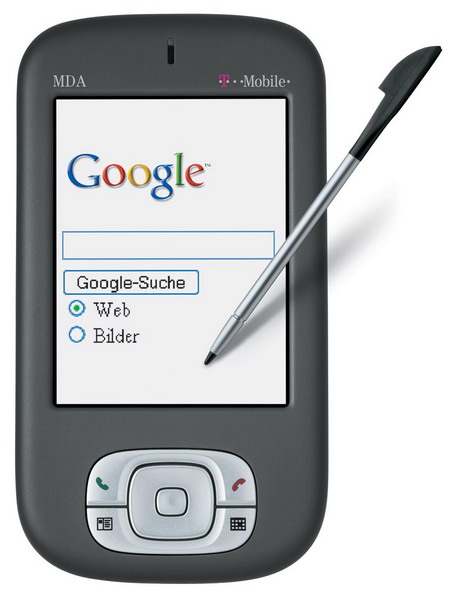
Resistive touch panels are used in PDAs, communicators, cell phones, POS terminals, as well as in industry (control devices) and medical equipment.
Capacitive
Capacitive touchscreen technology is based on the principle that a large capacitive object (in this case a person) has the ability to conduct electrical current. Capacitive technology works by applying an electrically conductive layer to the glass, and a weak alternating current is supplied to all four corners of the screen. If you touch the screen with a grounded object of large capacity (finger), current leakage will occur. The closer the touch point is to the electrodes in the corners of the screen, the greater the leakage current, which is recorded by the control electronics that determine the coordinates of the touch point.
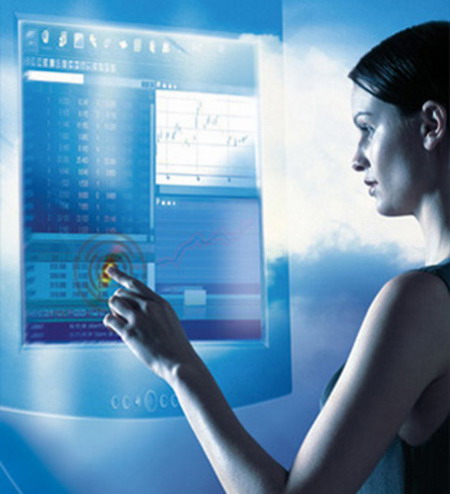
Capacitive displays are very reliable and durable, they are designed to last hundreds of millions of clicks, and they resist dirt well, but only those that do not conduct electricity. Compared to resistive screens, they are more transparent. However, there are still disadvantages: the possibility of damage to the electrically conductive coating and insensitivity to touch with non-conductive objects (gloved hands).
Capacitive screens are used in secure premises, information kiosks and some ATMs.
Projected capacitive
Projective capacitive screens use the measurement of the capacitance of a capacitor formed between the human body and a transparent electrode on the surface of the glass, which in this case is a dielectric. Due to the fact that the electrodes are located on the inner surface of the screen, the screen is very resistant to mechanical damage. Given the possibility of using thick glass, projected capacitive screens can be used in public places and outdoors without any restrictions, and what's more, this type of screen recognizes pressure from a gloved finger.
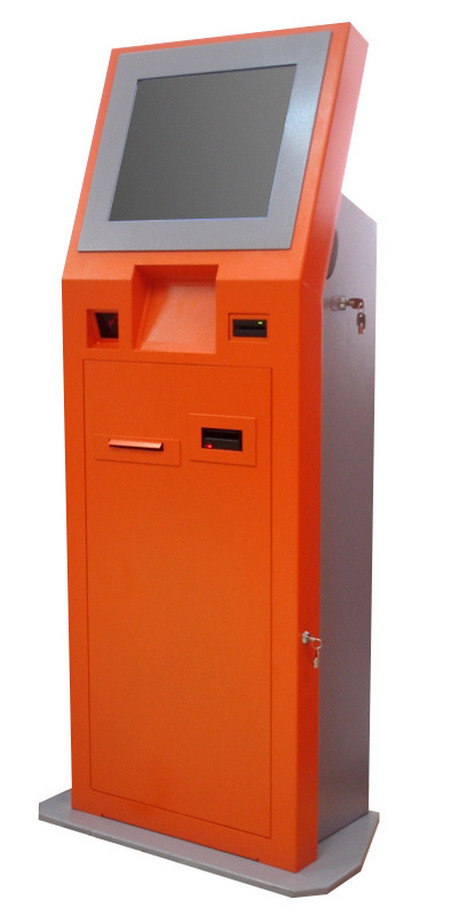
These screens are quite sensitive and distinguish between finger and conductive pen presses, and some models are capable of recognizing multiple presses (multi-touch). Advantages of a projective capacitive screen: high transparency, durability, insensitivity to most contaminants. The disadvantages of such a screen are the not very high accuracy and complexity of the electronics that calculate the coordinates of the press.
Projected capacitive screens are used in electronic kiosks on the streets, payment terminals, ATMs, laptop touchpads and iPhones.
With determination of surface acoustic waves
The principle of operation of the touch panel with the determination of surface acoustic waves is the presence of ultrasonic vibrations in the thickness of the screen. When you touch the vibrating glass, the waves are absorbed, and the point of contact is determined by the screen sensors. The advantages of these screens are high reliability and pressure recognition (unlike capacitive screens). The disadvantages are poor protection from the environment, so screens with surface acoustic waves cannot be used outdoors, and such screens are also afraid of any contamination that interferes with their operation. Rarely used.
Rare types touch screens
Optical screens. The glass is illuminated with infrared light, and as a result of touching it, light scatters, which is recorded by the sensor.
Induction screens. Inside the screen there is a coil and a grid of sensitive wires that respond to pressure from an active pen powered by electromagnetic resonance. Such screens respond to touches only with a special stylus. Used in expensive graphics tablets.
Strain gauge screens. They react to screen deformation and have low accuracy, but they are very durable.
Infrared ray grid. This is one of the very first technologies to recognize touches on the screen. The grid consists of a large number of light emitters and receivers located on the sides of the screen. Reacts to blocking of rays by objects and thus determines the coordinates of pressing.
Multi-touch
Multi-touch, which is talked about so much, is not a type of touch screen. Multi-touch technology - which is a loose translation of the phrase multi-touch - is additional option to a touch screen (usually using projected capacitive technology), allowing the screen to recognize multiple touch points. As a result, the multi-touch screen can recognize gestures. Here are just a few of them:
Move two fingers together to make an image or text smaller
Spread two fingers to the sides - enlarge the image
Moving multiple fingers at the same time - scrolling text or a page in a browser
Two finger rotation - rotate image
Advantages and disadvantages of touch screens
Touch screens have been used in portable devices for a long time. There are several reasons for this:
The ability to do not a large number of control buttons
Simple graphical interface
Ease of operation
Ease of access to device functions
Increased multimedia capabilities
However, touch screens also have a lot of disadvantages:
Lack of tactile feedback
Need to use a pen
Risk of screen damage
The appearance of fingerprints and dirt on the screen
Higher energy consumption
Thus, it is not always possible to completely get rid of the keyboard, because it is much more convenient to type text using regular keys. But the touch screen has greater interactivity, faster access to menu items and settings of modern devices.
If you go to a modern mobile phone store and get acquainted with the products on offer, the specifications for most devices on the display will indicate: “Screen type - capacitive.” Those who often change mobile communication devices are familiar with this term, but what to do if a person did not strive to buy the latest, preferring proven solutions? He can only be at a loss: “Capacitive screen - what is it?”
Data entry technology
The principle of touch typing is now used everywhere. For example, ATMs or machines for making various types of payments, on the panels of which there are a minimum of buttons, and the required numbers are entered by clicking on the corresponding image, can be found in almost every large store. were first proposed back in the seventies, but they were not widespread due to insufficient accuracy of recognition of the pressure zone and the complexity of implementation. But work to improve this solution continued.
Sensors in phones
When did models of mobile communication devices with large screens, the question immediately arose about ergonomics. Of course, it was possible to reduce the already small block of buttons, but this would have a very negative impact on ease of use. Compromise solutions were used - the so-called “sliders”, but this made the device too thick and made it less reliable due to the need to use a mechanical movable connection. Manufacturers began searching for a solution. And it was found. They turned out to be significantly improved by that time and ideally suited for telephones.
 Resisting pressure
Resisting pressure
The first models of such screens were made according to the resistive principle. Due to a number of features, such sensors are still used today. consists of two completely transparent plates: the outer one, which receives pressure, is made flexible, and the inner one, on the contrary, is rigid. The space between them is filled with a transparent dielectric material. An electrically conductive layer is sprayed onto both plates on the inner sides. It is specially connected by conductors to a controller that constantly supplies low voltage to the layers. This entire “sandwich” is fixed on the main display. When a person presses on a section of the screen, the plates touch at a certain point, causing a current to flow. By determining the resistance values along two Cartesian axes, you can find out with sufficient accuracy exactly where the pressing occurred. This data is transferred to the running program, which further processes it.  Resistive sensors are inexpensive to produce and work well at low temperatures.
Resistive sensors are inexpensive to produce and work well at low temperatures.
Capacitive screens
Sensors operating on the capacitive principle are much more advanced. Touchpads in laptops are a prime example of such solutions. On foreign websites, the characteristics of phones with this technology indicate “Capacity”. Unlike the resistive solution described above, mechanical pressing is not at all important here. IN in this case The human body's ability to accumulate is used, acting as a classic capacitor. Capacitive screens are more durable and have excellent responsiveness. There are two implementation methods: surface and projection. In the first case, a transparent layer of conductive material is applied to the surface of glass or plastic. It is constantly exposed to electrical potential from the controller. Just touch a point on the screen with your finger, and the battery leaks into the human body. It can be easily determined and the coordinates transferred to the running program. Projected capacitive screens work differently. Behind the outer glass of the display is a grid transparent elements sensor (they can be seen at a certain angle and lighting). If you touch the point, then, in fact, a capacitor will be formed, one of the plates of which is the user’s finger. The capacitance in the circuit is determined by the controller and calculated. This decision allows you to implement multi-touch technology.
If you are not one of the tech-savvy users and you will soon be faced with the question of choosing a mobile phone or smartphone with a touch screen, you will probably come across terms such as “capacitive screen” or “resistive screen” when reading the specifications of mobile devices. And then a completely logical question will come to your mind - which one is better: resistive or capacitive? Let's find out how touch displays differ, what types exist, and what their advantages and disadvantages are.
RESISTIVE SCREENS
To put it in simple language, avoiding clever technical terms and phrases, a resistive touch screen is a flexible transparent membrane on which a conductive (in other words, resistive) coating is applied. Under the membrane there is glass, also covered with a conductive layer. The principle of operation of a resistive screen is that when you press the screen with a finger or stylus, the glass closes with the membrane at a specific point. The microprocessor records the change in membrane voltage and calculates the contact coordinates. The more precise the press, the easier it is for the processor to calculate the exact coordinates. Therefore, with resistive screens it is much easier to work with a stylus.
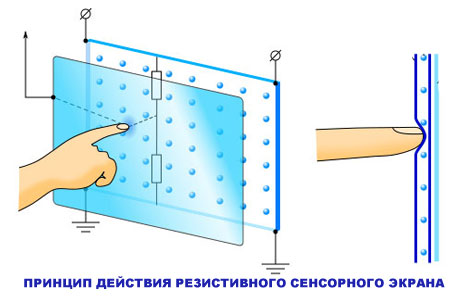
The main advantages of resistive screens are that they are relatively cheap to produce, and also that this type of display responds to pressure from any object. This is very useful when making presentations, especially since the prices of projectors today are falling every day.
The disadvantages of resistive screens are: low strength; low durability (about 35 million clicks per point); impossibility of implementation; big number errors when processing gestures such as sliding and flipping.
So which screen is better: resistive or capacitive?
If you read carefully this article, then you can draw your own conclusion without any problems. I will only say that this dispute is doomed to failure. Some users like to work with a stylus and are not comfortable with capacitive displays. But most people are more comfortable operating a device equipped with a capacitive screen - it’s more convenient, and the multi-touch feature makes a big difference. It's not all for nothing modern smartphones and tablets running under Android control, have capacitive displays.
The screens of modern devices can not only display images, but also allow you to interact with the device through sensors.
Initially, touch screens were used in some pocket computers, and today touch screens are widely used in mobile devices, players, photo and video cameras, information kiosks, and so on. Moreover, each of the listed devices can use one or another type of touch screen. Currently, several types of touch panels have been developed, and, accordingly, each of them has its own advantages and disadvantages. In this article we will look at what types of touch screens there are, their advantages and disadvantages, and which type of touch screen is better.
There are four main types of touch screens: resistive, capacitive, with the detection of surface acoustic waves and infrared . In mobile devices, only two are most widespread: resistive and capacitive . Their main difference is the fact that resistive screens recognize pressure, while capacitive screens recognize touch.
Resistive touch screens
This technology is most widespread among mobile devices, which is explained by the simplicity of the technology and low production costs. The resistive screen is LCD display, on which two transparent plates are superimposed, separated by a dielectric layer. The top plate is flexible, as the user presses on it, while the bottom plate is rigidly fixed to the screen. Conductors are applied to surfaces facing each other.
 |
|
Resistive touch screen |
The microcontroller supplies voltage in series to the electrodes of the top and bottom plates. When the screen is pressed, the flexible top layer flexes and its inner conductive surface touches the lower conductive layer, thereby changing the resistance of the entire system. The change in resistance is recorded by the microcontroller and thus the coordinates of the touch point are determined.
The advantages of resistive screens include simplicity and low cost, good sensitivity, and the ability to press the screen with either a finger or any object. Among the disadvantages, it is necessary to note poor light transmission (as a result, you have to use a brighter backlight), poor support for multiple clicks (multi-touch), they cannot determine the force of pressing, as well as fairly rapid mechanical wear, although in comparison with the life of the phone, this disadvantage is not so important, since the phone usually fails faster than the touch screen.
Application: Cell Phones, PDAs, smartphones, communicators, POS terminals, TabletPC, medical equipment.
Capacitive touch screens
Capacitive touch screens are divided into two types: surface-capacitive and projected-capacitive . Surface capacitive touch screens They are glass on the surface of which a thin transparent conductive coating is applied, on top of which a protective coating is applied. Along the edges of the glass there are printed electrodes that supply a low-voltage conductive coating AC voltage.
 |
|
Surface capacitive touch screen |
When you touch the screen, a current pulse is generated at the point of contact, the magnitude of which is proportional to the distance from each corner of the screen to the point of contact, thus, it is quite simple for the controller to calculate the coordinates of the point of contact and compare these currents. Among the advantages of superficial capacitive screens It can be noted: good light transmission, short response time and long touch life. Among the disadvantages: the electrodes placed on the sides are not suitable for mobile devices, they are demanding on external temperature, they do not support multi-touch, you can touch them with your fingers or a special stylus, and they cannot determine the pressing force.
Application: Information kiosks in secure areas, at some ATMs.
Projected capacitive touch screens They are glass with horizontal leading lines of conductive material and vertical defining lines of conductive material applied to it, separated by a layer of dielectric.
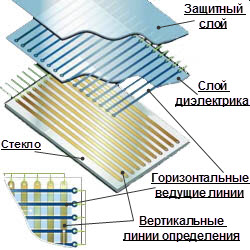 |
|
Projected capacitive touch screen |
Such a screen works as follows: a microcontroller sequentially applies voltage to each of the electrodes in the conductive material and measures the amplitude of the resulting current pulse. As the finger approaches the screen, the capacitance of the electrodes located under the finger changes, and thus the controller determines the location of the touch, that is, the coordinates of the touch are intersecting electrodes with increased capacitance.
The advantage of projected capacitive touch screens is their fast touch response speed, multi-touch support, more accurate coordinate determination compared to resistive screens, and pressure detection. Therefore, these screens are used to a greater extent in devices such as the iPhone and iPad. It is also worth noting the greater reliability of these screens and, as a result, a longer service life. Among the disadvantages, it can be noted that on such screens you can only touch with your fingers (drawing or writing by hand with your fingers is very inconvenient) or with a special stylus.
Application: payment terminals, ATMs, electronic kiosks on the streets, touchpads of laptops, iPhone, iPad, communicators and so on.
SAW touch screens (surface acoustic waves)
Composition and principle of operation of this type screens are as follows: piezoelectric elements are placed at the corners of the screen, which convert the electrical signal supplied to them into ultrasonic waves and direct these waves along the surface of the screen. Reflectors are distributed along the edges of one side of the screen, which distribute ultrasonic waves across the entire screen. On the opposite edges of the screen from the reflectors there are sensors that focus ultrasonic waves and transmit them further to the transducer, which in turn converts the ultrasonic wave back into an electrical signal. Thus, for the controller, the screen is represented as a digital matrix, each value of which corresponds to a specific point on the screen surface. When a finger touches the screen at any point, waves are absorbed, and as a result, the overall pattern of propagation of ultrasonic waves changes and as a result, the transducer produces a weaker electrical signal, which is compared with the digital matrix of the screen stored in memory, and thus the coordinates of touching the screen are calculated.
 |
|
SAW touch screen |
The advantages include high transparency, since the screen does not contain conductive surfaces, durability (up to 50 million touches), and surfactant touch screens allow you to determine not only the coordinates of pressing, but also the pressing force.
Among the disadvantages, we can note the lower accuracy of determining coordinates than capacitive ones, that is, you won’t be able to draw on such screens. A big disadvantage is malfunctions when exposed to acoustic noise, vibrations or when the screen is dirty, i.e. Any dirt on the screen will block its operation. Also, these screens only work correctly with objects that absorb acoustic waves.
Application: surfactant touch screens mainly in secured information kiosks, in educational institutions, in slot machines and so on.
Infrared touch screens
The design and operating principle of infrared touch screens is quite simple. Along two adjacent sides of the touch screen there are LEDs that emit infrared rays. And on the opposite side of the screen there are phototransistors that receive infrared rays. Thus, the entire screen is covered with an invisible grid of intersecting infrared rays, and if you touch the screen with your finger, the rays overlap and do not hit the phototransistors, which is immediately registered by the controller, and thus the coordinates of the touch are determined.
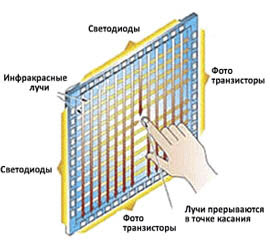 |
|
Infrared touch screen |
Application: Infrared touch screens are mainly used in information kiosks, vending machines, medical equipment, etc.
Among the advantages we can note the high transparency of the screen, durability, simplicity and maintainability of the circuit. Among the disadvantages: they are afraid of dirt (therefore they are used only indoors), cannot determine the force of pressing, average accuracy in determining coordinates.
P.S. So, we have looked at the main types of the most common sensor technologies (although there are also less common ones, such as optical, strain gauge, induction, and so on). Of all these technologies, resistive and capacitive ones are most widely used in mobile devices, as they have high accuracy in determining the point of contact. Of them best characteristics have projected capacitive touch screens.
The text was prepared based on materials from open sources Methodists in Technology Karabin A.S., L.V. Gavrik, S.V. Usachev
